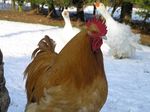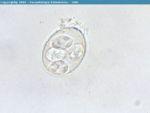Coccidia - Poultry
Introduction
Domestic poultry and birds are affected by coccidia called Eimeria. Different species of Eimeria that effect poultry are host-specific – meaning that a species that infects chickens does not infect turkeys and vice versa.
Nine species of Eimeria infect chickens. The species important in broiler production include Eimeria tenella (90%), E. maxima, E. acervulina, and E. mivati; the species important in breeder and egg- layers are E. burnetti and E. necatrix. Seven species infect turkeys – the big three of concern are Eimeria meleagrimitis, E. adenoeides, and E. gallapovonis. Currently 13 species of coccidia have been reported in ducks but only certain species have been researched. Eimeria, Wenyonella or Tyzzeria genuses are found in wild and farmed birds. There are three main species of coccidia in pheasants, all three of which fall into the Eimeria genus. In Geese, there are two strains Eimeria truncata and E. anseris, which are of most pathogenic importance, with the latter causing intestinal disease and E. truncata causing renal coccidiosis.
Coccidia have a direct life cycle, with a one week prepatent period. After oocysts are ingested, sporozoites are released which penetrate the intestinal epithelium and 2 asexual phases of multiplication called schizogony occur followed by a phase of sexual multiplication called gametogony.The zygote develops into an oocyst which is then shed in the faeces. An oocyst measures around 20-30μm and for each oocyst ingested, thousands are shed. The life cycle is self-limiting and organisms from a single infection go through the sequence of developmental stages synchronously. Organisms leave the body simultaneously as oocysts. Oocysts are only infective once they have sporulated and sporulation requires warmth, moisture and oxygen; this will take around 2-3 days in broiler house.
Clinical Signs
In most poultry animals, severe enteritis is the main clinical symptom. Haemorrhagic diarrhoea is seen with the most pathological strains of the disease along with mucoid discharge. Weight loss, general malaise, depression, reduced appetite and depression are other common signs. Sudden death can occur, often in younger birds. Morbidity is usually very high but mortality is variable. In geese, renal coccidiosis can occur and signs include severe depression such as reduced appetite and huddling, emaciation and diarrhoea. Mortality rates are high, however, birds that recover from the infection remain strongly resistant to it for life.
Diagnosis
Clinical signs and history are usually enough to make a presumptive diagnosis. Post mortem examination should be performed on sick birds that are not likely to recover (these will be sacrificed for this purpose) and the lesions examined. Observation of caseous core lesions in the caecum and sloughing of the intestinal walls will strengthen a presumptive diagnosis. A sample of mucosa should be taken for examination under the microscope in order to identify oocysts, which will confirm the diagnosis. Specific identification of genus of coccidia is not required as treatment is the same for all.
Treatment and Control
Control is dependent on hygiene and good husbandry, such as disinfection of housing and good ventilation. It is important to prevent wild birds entering the housing or defaecating in the housing as this is a common cause of spread of the disease.
If an outbreak does occur, treatment is usually with sulphonamides. Other anit-coccidial drugs have varying degrees of safety and effiacy in different poultry species.
References
Merck & Co (2008) The Merck Veterinary Manual (Eighth Edition) Merial
Jordan, F, Pattison, M, Alexander, D, Faragher, T, (1999) Poultry Diesease (Fifth edition) W.B. Saunders
Randell, C.J, (1985) Disease of the Domestic Fowl and Turkey, Wolfe Medical Publication Ltd
Saif, Y.M, (2008) Disease of Poultry (Twelfth edition) Blackwell Publishing

